On June 5-7, 2020, the Institute for Economic and Social Research (IESR) at Jinan University and the Global Labor Organization (GLO) jointly organized a virtual conference, following the 2019 joint workshop on Belt and Road labor markets and the 2018 joint workshop.
This year’s conference took place in the backdrop of the Covid-19 pandemic, thus providing a platform for economists from all over the world to discuss its multifold impact on the economics. The event attracted over 300 participants from all across the globe.
Novel coronavirus (Covid-19) pandemic, as GLO president Klaus F. Zimmerman pointed out in the opening, has become an ultimate threat to the globalization. However, global collaboration is precisely what we need in the times like this to be able to defeat this crisis, and that is exactly what has spurred this joint IESR and GLO initiative this year.
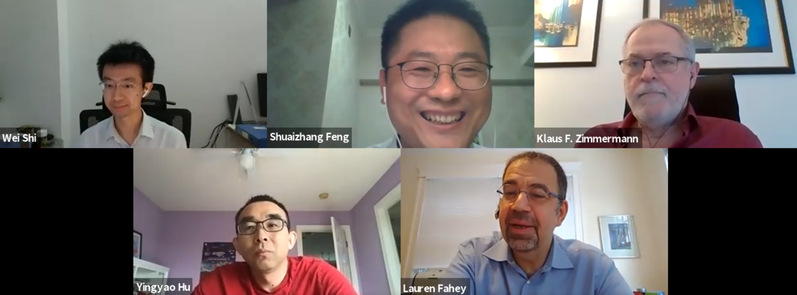
The conference featured two keynote addresses by Daron Acemoglu (MIT) and Charles Manski (Northwestern University), as well as 16 speakers from the universities and research institutions worldwide, including MIT, University of Pittsburgh, Brigham Young University, Ohio State University, University of Edinburgh, ETH Zurich, Monash University, HKUST, Jinan University, and others. Each conference presenter also had an assigned discussant (check out full program here).
IESR Dean Shuaizhang Feng and Yingyao Hu from Johns Hopkings University were also present throughout the conference and opening remarks, briefly introducing our institute and the upcoming econometrics camp this August 10-14, organized by the Center for Econometrics and Microdata Practice of IESR.
Brief recap of the IESR-GLO conference on the economics of Covid-19
Keynote address by Daron Acemoglu (MIT)


Optimal Targeted Lockdowns in a Multi-group SIR Model
Abstract:
We develop a multi-risk SIR model (MR-SIR) where infection, hospitalization and fatality rates vary between groups—in particular between the “young”, “the middle-aged” and the “old”. Our MR-SIR model enables a tractable quantitative analysis of optimal policy similar to those already developed in the context of the homogeneous-agent SIR models. For baseline parameter values for the COVID-19 pandemic applied to the US, we find that optimal policies differentially targeting risk/age groups significantly outperform optimal uniform policies and most of the gains can be realized by having stricter lockdown policies on the oldest group. Intuitively, a strict and long lockdown for the most vulnerable group both reduces infections and enables less strict lockdowns for the lower-risk groups. We also study the impacts of social distancing, the matching technology, the expected arrival time of a vaccine, and testing with or without tracing on optimal policies. Overall, targeted policies that are combined with measures that reduce interactions between groups and increase testing and isolation of the infected can minimize both economic losses and deaths in our model.
Keynote address by Charles Manski (Northwestern University)

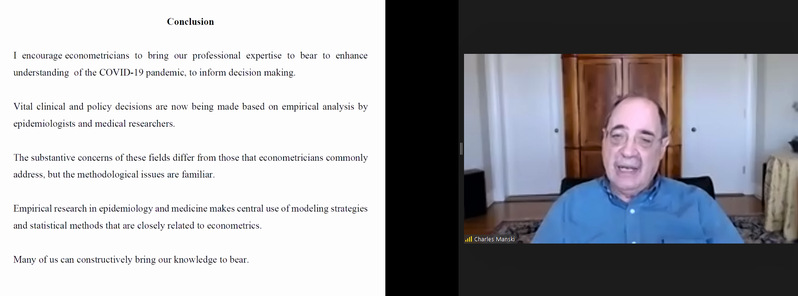
Coping with COVID Uncertainties
Abstract:
Treatment of COVID-19 and policy formation must cope with many uncertainties about the nature of the disease and the dynamics of the pandemic. These uncertainties have been well-recognized qualitatively, but they have not been well-characterized quantitatively. Credible measurement of COVID uncertainties is needed to make reasonable clinical and policy decisions. I will discuss research on several uncertainties relevant to decision making.
Regular sessions
In addition, the conference featured 6 regular sessions, each comprising of 2-3 papers on Covid-19 spanning across different areas in economics.
June 5, 1st session | Xiaodong Fan (Monash University), Kelly Hyde (University of Pittsburgh) and Mahreen Khan (MIT) | Discussed by Yang (Zoe) Yang (CUHK), Yun Qiu (IESR) and Shu Cai (IESR)
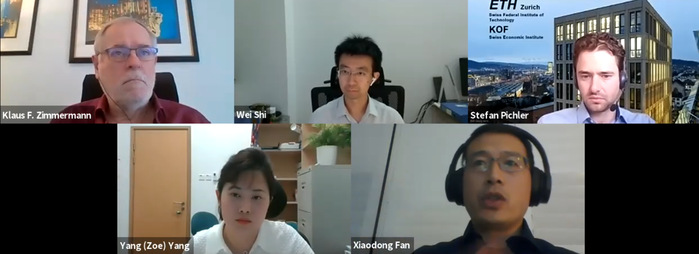
Fan et al. studies the spillover effects of local lockdown measures on slowing down the COVID-19 spread in the United States and finds that the spillover effects operate through restricting travel and non-essential visits and raising the awareness of the virus. These results suggest the need for coordination across regions when fighting pandemics like COVID-19.
Hyde studies the association between residential water quality and the spread of COVID-19 in the United States. Combining four measures of residential water infrastructure quality such as lead exposure risk score and bottled water share of grocery expenditure, he finds that COVID-19 cases grew faster in areas at higher risk of lead exposure through poor quality residential water infrastructure. This paper suggests the distribution of potable water to water-poor households may help slow the spread of COVID-19 in the short term.
Kahn et al. constructs a migration-based index of COVID-19 risk exposure and validates the index by comparing it to the number of confirmed COVID-19 cases and deaths. They use the index to construct sub-national heat maps of COVID-19 risk to guide spatial allocation of financial support, public health measures, or lockdowns and quarantines.
June 5, 2nd session | Pablo de Pedraza (JRC European Commission) and Riley Wilson (Brigham Young University) | Discussed by Xi Chen (Yale) and Jun Hyung Kim (IESR)
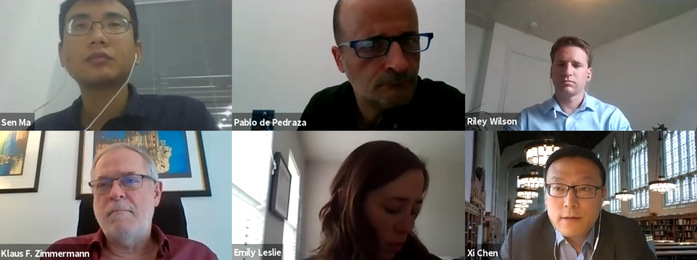
Pedraza et al. conducts a cross-country comparative analysis using data from 25 advanced and developing countries. They find that restriction on mobility and the increase in COVID 19 cases raise dissatisfaction and anxiety, and the effects are heterogenous across population with different characteristics.
Wilson and Leslie show that anxiety due to the shelter at home policy may eventually lead to more domestic violence using data from the United States.
Both studies point out significant negative impacts of lockdown policy, which policy makers need to take into consideration.
June 6, 1st session | Peng Nie (Xi'an Jiaotong University), Xianqiang Zou (Renmin University of China) and Osea Giuntella (University of Pittsburgh) | Discussed by Osea Giuntella, Jubo Yan (Nanyang Technological University) and Peng Nie
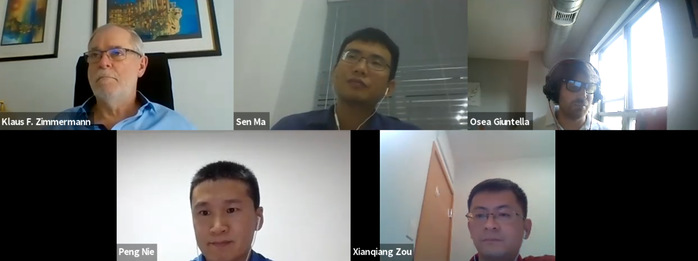
Nie et al. constructs survey-based measures of over and under confidence in the health self-perceptions among Chinese adults during the COVID-19 pandemic and studies their association with mental health outcomes. They find that health overconfidence can significantly predict depression and lower levels of happiness and life satisfaction and these effects are stronger in regions that experienced higher numbers of confirmed COVID-19 cases and deaths. The results emphasize the importance of using interventions to temper overconfidence during COVID-19.
Zou et al. studies the impact of COVID-19 on people’s willingness to take risks, trust of other people, and mental health using a national online survey conducted during late March and early April in China. They find that people in neighborhoods with more confirmed cases became more risk-averse, less likely to trust others, and more depressed, and COVID-19 increased the unemployment rate and decreased workers’ wages.
Giuntella et al. studies the impact of COVID-19 on undergraduate students’ mental health and well-being using a sample of students who received wearable devices (Fitbits) for an ongoing wellness study. They find that students have experienced major disruptions in physical activity, sleep quality and social connections, along with strong declines across various mental well-being measures after the pandemic happened. They suggest that during COVID-19 the disruption of routines and the exposure to negative news dramatically emerge as predictors of changes in mental health.
June 6, 2nd session | Bruce A. Weinberg (Ohio State University) and Sen Ma (IESR) | Discussed by Sen Ma and Bruce A. Weinberg

Weinberg et al. introduces several studies documenting the early labor market impacts of the COVID-19 outbreak. They find that the decline in employment is larger among women, Hispanics, younger workers, and works that require more face-to-face interaction.
Ma et al. explores a specific mechanism: school shutdown can affect the labor supply of parents due to the increasing needs for childcare. Using survey data from China, they find that parents, especially mothers who are experiencing an increasing demand for childcare are less likely to return to work.
Both studies show that COVID-19 related policies significantly increase the burden on the labor force.
June 7, 1st session | Jianan Lu (University of Edinburgh), Lamis Kattan (University of Ottawa) and Stefan Pichler (ETH Zurich) | Discussed by Lamis Kattan, Stefan Pichler and Jianan Lu
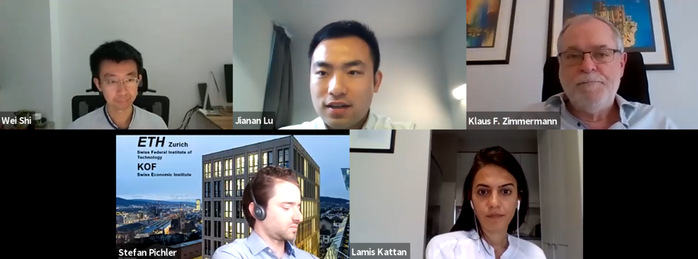
Lu et al. studies the impact of social trust on the spread of COVID-19 in China using CHIP, WVS, and CFPS. They find that residents would be more willing to follow and maintain the quarantine instruction of local government and reduce their mobility in regions with higher local trust levels.
Kattan et al. studies the socioeconomic determinants of COVID-19 stay-at-home orders’ compliance in the U.S. They find that stay-at-home orders reduce mobility by about 8-10 percentage points; high-trust counties decrease their mobility significantly more than low-trust counties post-lockdown; and counties with relatively more self-declared democrats decrease significantly more their mobility.
Stefan Pilcher et al. finds that COVID-19 emergency sick leave has helped to flatten the curve.
June 7, 2nd session | Domenico Depalo (Bank of Italy), Robin Kaiji Gong (HKUST) and Sergio Scicchitano (INAPP) | Discussed by Shengjie Hong (Tsinghua University), Sergio Scicchitano and Robin
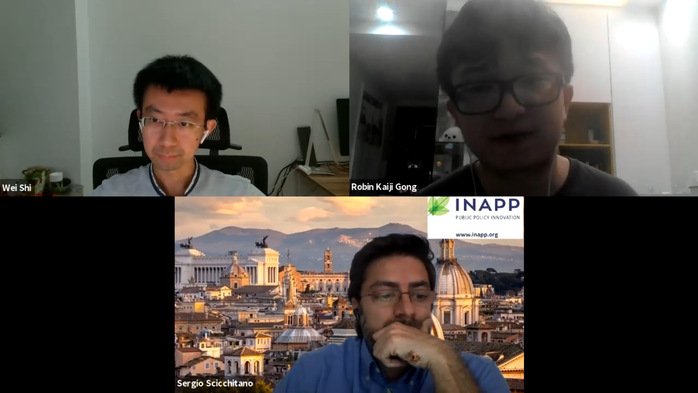
Depalo et al. develops a new econometric method based on partial identification to estimate the true mortality rate of COVID-19 in the Italian region.
Gong et al. studies the impact of policy interventions on the performance of Chinese small and medium enterprises during the pandemic, using nationally representative survey data from China.
Scicchitano et al. estimates the potential impacts of lockdown policy on Italian labor force through analyzing the content of Italian occupations operating in about 600 sectors with a focus on the dimensions that expose workers to contagion risks.
Conference organizers
Institute for Economic and Social Research (IESR) was founded at Jinan University in December 2015. Since then, IESR has played a leading role in economics education, research, public service, and international cooperation. Operating under the leadership of internationally renowned scholars, including Professor Shuaizhang Feng as Dean and Professor James Heckman as Chair of the Advisory Board, IESR currently has 42 full-time faculty members, many of whom are graduates of renowned institutions such as Yale University, University of Chicago, LSE, UC Berkeley, and UCLA. Research at IESR covers all major economic fields, and undergraduate and graduate students receive rigorous training in economics. The Institute runs a Survey Data Center for data collection and management, as well as a Policy Research Center for policy analysis and evaluation.
The mission of the Institute is to advance policy-oriented economic and social research by addressing pressing social and economic issues in China. Our work is driven by the following objectives:
Developing China-based research programs in applied economics and other fields
Collecting original survey data related to China’s economic and social development
Building a leading Chinese think tank to inform and influence national policymaking
Guiding IESR students to become future leaders in economic and social research
Facilitating academic exchanges between scholars in China and abroad
Global Labor Organization (GLO) is an international, independent, non-partisan and non-governmental organization that has no institutional position. It deals with the challenges and benefits of globalization and international collaborations since March 2017. The GLO functions as a global network and virtual platform for researchers, policy makers, practitioners and the general public interested in scientific research and its policy and societal implications on global labor markets, demographic challenges and human resources. These topics are defined broadly to embrace the global diversity of markets, institutions, and policy challenges, covering advanced economies as well as transition and less developed countries.
The GLO is a leading and global research and policy network on labor, demographics and human resources.
The GLO is supported by individuals as well as organizations with a thematic interest and a strong ambition to contribute to an effective global network and to benefit from it.
The GLO Network currently consists of over 1,600 individuals and 35 organizations covering over 120 countries.



